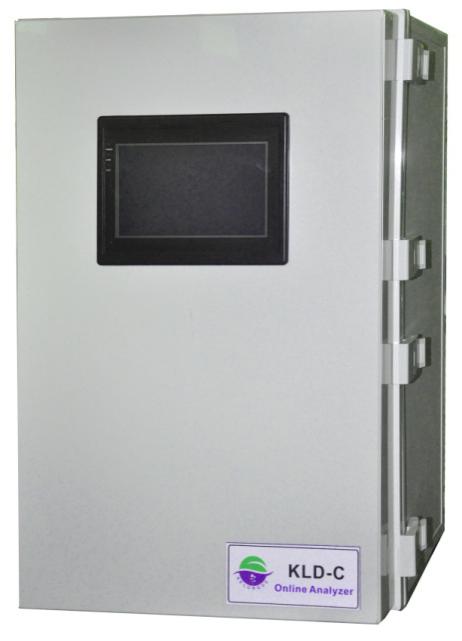KLD-C MPA (COD, TOC, BOD, PO4, NH3-N, SiO3 & optional EC/PH/ORP/TS/SS/DO) is an automatic on-line analyzer independently developed by Xiamen Kelungde Env. Engineering Co.,Ltd. Using imported CPU, highly precise signal processor and simple but steady hydraulic system to effectively reduce signal fluctuation and to ensure the accuracy and stability of data. Complete separation between electronics and hydraulics allows long-term & stable running. It is suitable for several types of water matrix like river water, surface water and industrial effluent.

Features
1.Robust & Reliable
Designed for on-line industrial and environmental applications. Complete separation between electronics and hydraulics allows long-term stable operations.
2.Precise Reagent Dosage
CPU controlled photoelectric dosing system for accurate reagent dosage. Simple & steady structure ensures long-term service life.
3.Easy Installation
Delivered after a long & successful series of factory tests, it is ready for installation and setup. To start monitoring just need to connect reagent tubes, sample tube, water tube, waste tube and power supply, then set up the parameters.
4.Automatic Calibration
The analyzer performs calibration according to the calibration interval and type set up by users. If the result exceeds selected limits, the original calibration parameters will not be updated and an alarm signal will be outputted.
5.Automatic Monitoring
Measuring interval can be freely set up by users. Between two measurements the analyzer remains in standby.
Benefits
Ø Automatic monitoring system gives alarm signal in abnormal condition. Easy and low maintenance; Low operating cost.
Ø 4-20mA analog signal output; standard RS232, RS485 digital signal output, MODBUS protocol.
Ø New signal processor reduces signal fluctuation to ensure the accuracy and stability of data.
Ø Highly precise peristaltic pump extends the service life of pump tubes.
Ø Automatic restart when normal power supply after accidental power down.
Ø Remote control with local or remote PC connection.
Ø Low reagent consumption; short preparation time.
Ø Automatic diagnosis function. Identification and alarm for reagent shortage.
Ø Instrument operating signal output function.
Ø 10000 groups of data storage and USB download for analysis data and running log.
Ø Easy operation, no special training is required.
Ø Controllable running of water pump and free setup for the sampling time of the pump.
Ø Security management function, automatic record and storage for all control operations. Read-only storage.
Ø 2-level operation & management authorization: The system administrator can have all system operation and general operators can only perform routine maintenance & operation.
Ø APP availble for the control of the analyzer. It can be used on the mobile devices using Android operating system, allowing to accomplish following tasks: reverse control of the instrument; read real-time param. & data; upload & view data; sign in with pic.; record the real-time latitude & longitude of sign in; automatic generation of operation & maintenance records.
Optional Function
Dual-channel
One analyzer to monitor on-line for 2 outlets.
Reagent Cooling
Longer reagent service life and less reagent replacing.
Alarm Function
DI water low limit alarm and waste liquid high limit alarm function.
Automatic Dilution Function
Automatic dilution function for high concentration sample.
Mini Printer
Print data after measurement.
Measuring Principle
TOC&COD&BOD (UV Method)
According to the ultraviolet light absorption effect of unsaturated organic molecules at particular wavelength , and then calculated by law of Lambert-Beer. Usually a sample is a mixture of many different molecules to form an average absorption coefficient. The instrument must be calibrated by using laboratory-calibrated TOC/COD/BOD values before use. Also, the proportions of the different molecules should be kept approximately constant to ensure good TOC/COD/BOD correlation. SAC UV absorption method is fast, reliable, low input & maintenance.
Phosphat
The sample after proper filtration is pumped into reactor, where molybdate is injected to form phosphorus-molybdenum heteropoly acid. Then to inject ascorbic acid into the sample. After fully mixing and reaction, the analyzer measures ABS value of blue substances produced by reaction at the specific wavelength, then calculates sample concentration according to the stored calibration data.
Silicate
The sample after proper filtration is pumped into reactor, where molybdate is injected to form silico-molybdic heteropoly acid. Then to inject oxalic acid and 4-Methylaminophenol sulfate-sodium sulfite solution into the sample. Oxalic acid is used to minimize the phosphate interference. After fully mixing and reaction, the analyzer measures ABS value of blue substances produced by reaction at 810nm, then calculates sample concentration according to the stored calibration data.
Ammonia (Gas Sensoring Electrode Method)
The sample after proper filtration is pumped into reactor, Inject reagent to adjust PH value over 12, which will convert all ammonium ion into ammonia which penetrates through electrode membrane. The variation of electrode potential and ammonia value changed in logarithm relation and then calculate the sample concentration.
Specification
Measuring Principle | TOC&COD&BOD: UV Method PO4/SiO3: Colorimetry NH3-N: Electrode Method |
Operating Management | Security management and 2-level operation management function |
Measuring Type | Manual or automatic with interval |
Measuring Interval | Programmable; reverse control available by RS232 |
Measuring Time | TOC&COD&BOD: 9 min PO4/SiO3/NH3-N: 10 min |
Measuring Range | Ranges available on request |
Calibration Type | Manual or automatic with interval |
Precision | ≤ 3% |
Accuracy | ±3% |
Zero Drift | 3%F.S |
Range Drift | 3%F.S |
Signal Output | Standard 4-20mA analog output, Standard RS232/RS485 digital output, MODBUS Protocol |
Alarm | High limit alarm, low limit alarm, reagent shortage alarm, calibration error alarm (standard) |
Sample and Waste Delivery | Pressure free |
Reagent Temperature | 10-30°C |
Reagent Replacement | 3~4 weeks (depending on the ambient temperature) |
Ambient temperature | 5-40°C |
Protection | IP55 |
MTBF | >720h |
Display | Color touch screen (language: Chinese Simplified, Chinese Traditional, English) |
Power supply | 230V AC±10%; 50-60 Hz |
Weight | 20 kg (without reagents) |
Dimension | 600x400x300mm(H x W x D) |